The city of Split is beautifully located along the Croatian Adriatic coast, and it is a city and area with a long and interesting history that can be easily and immediately seen and enjoyed on a stroll around the city center.
The original town in the area was situated a bit north of modern-day Split, but then Diocletian became Roman ruler. Diocletian chose to resign as emperor to a colossal palace at his hometown, and it formed the center of the development of the present Split.
The preserved parts of the Diocletian’s palace, built at the beginning of the 300s, stand today as Split’s foremost historical sites. For example, the Diocletian mausoleum forms the city’s cathedral, and parts of the palace and its basements are accessible today as well. The cellars are used as an vibrant street market.
Split has grown and expanded around the imperial palace over time, and here are beautiful Venetian-inspired architecture, interesting museums and a scenic location as some of the many sights and excursion destinations. Behind the outer walls of the palace the streets are narrow and alomst form a maze to explore.
Along the beautiful Adriatic Sea you find the promenade Riva, which is beautifully set at the foot of the Diocletian’s Palace. From Riva you can walk to the city marina and from here enjoy the view to Split’s skyline. There are beautiful views of the sea on both sides of Split’s center, and lovely beaches are also close by.
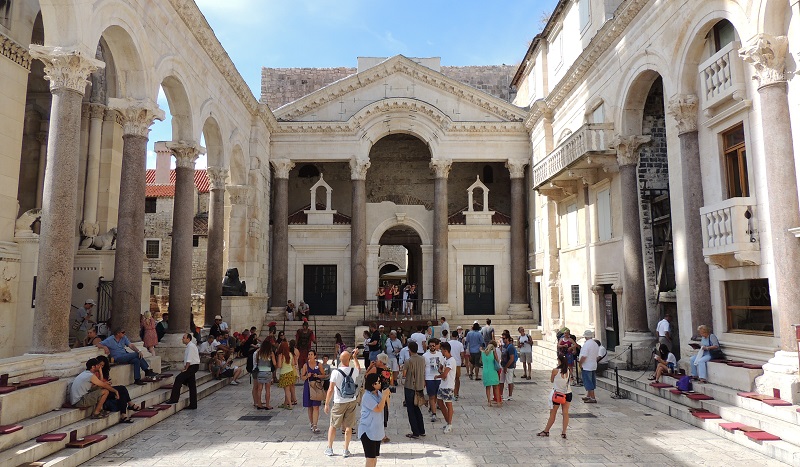
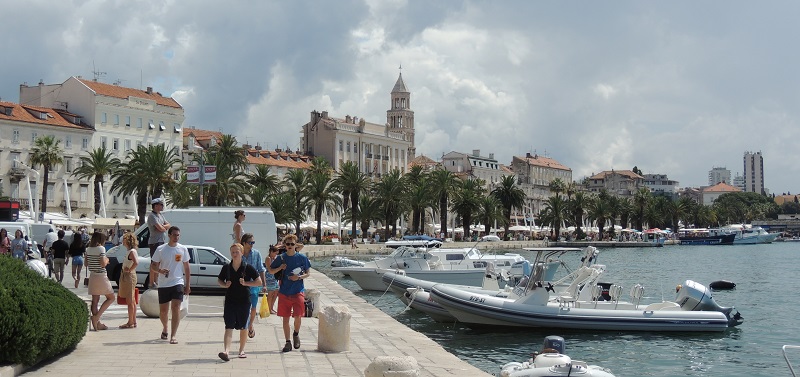
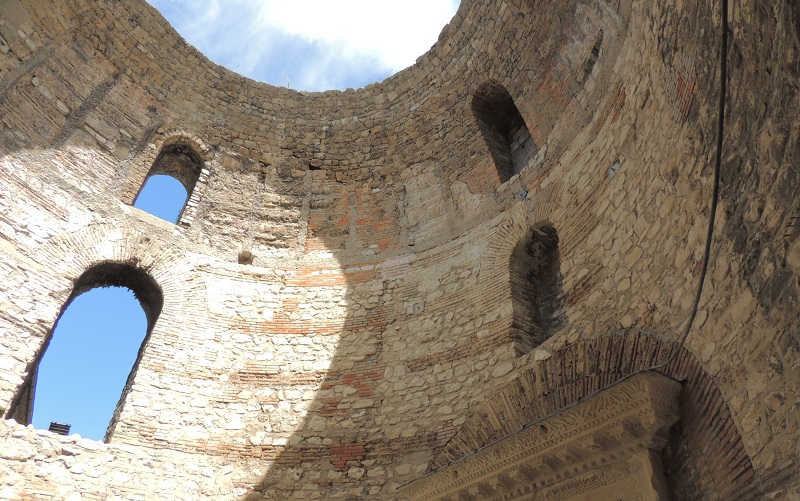
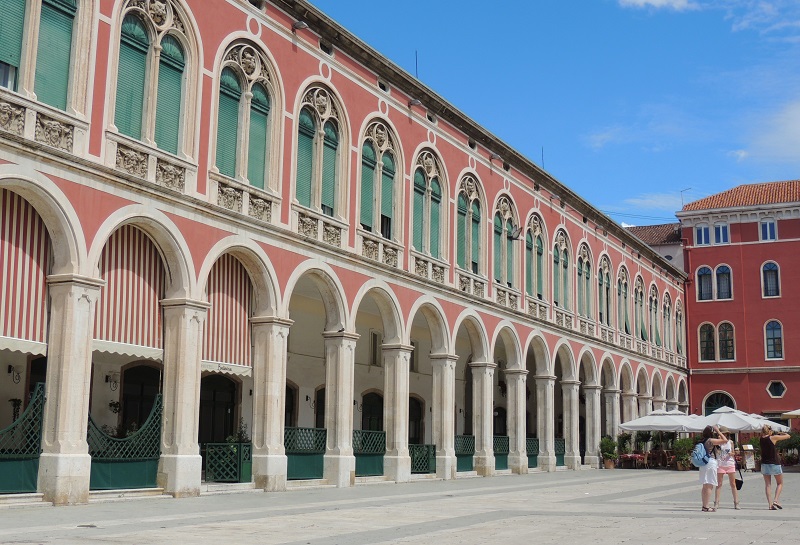
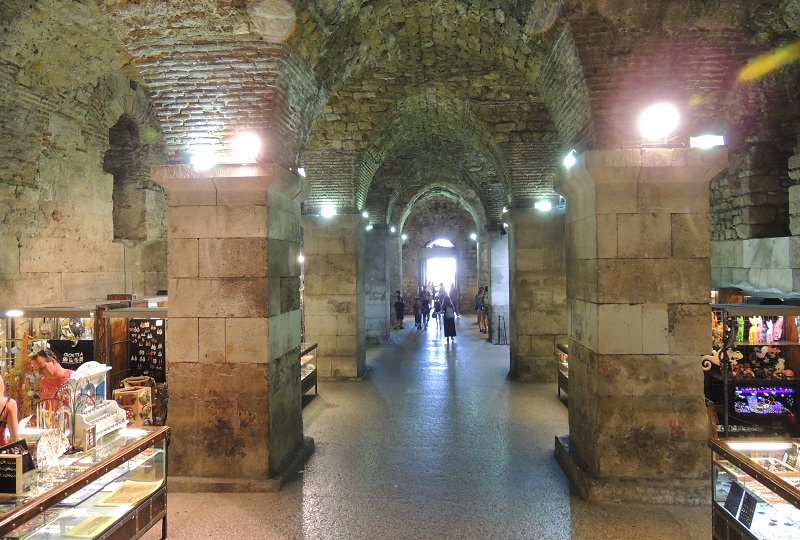


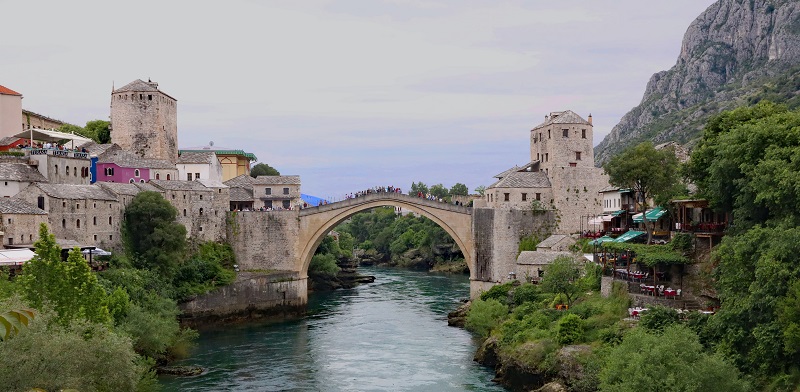
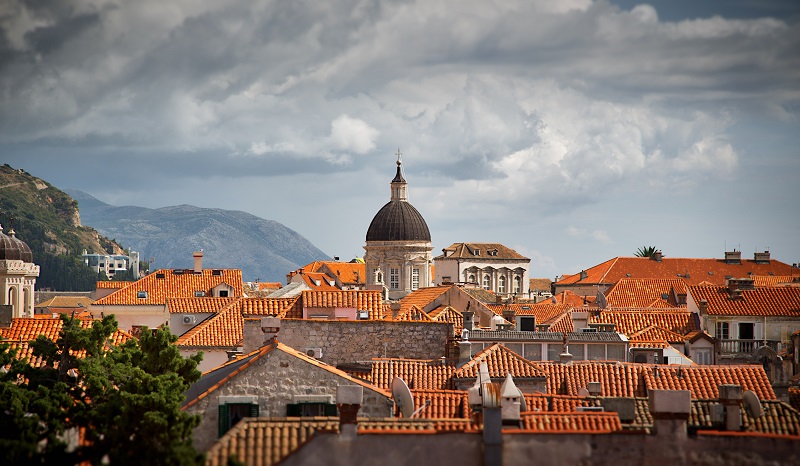
The Greek Founding
In the 300s BC Greek colonists established themselves at present Split. It happened in the form of the settlement Spalathos.
The inhabitants of Spalathos came from the city of Issa, which was itself a colony of Syracuse, whose inhabitants had originally come from Corinth. The Greeks of Spalathos lived by trade with Illyrian tribes in the vicinity.
The Roman Republic
Rome grew stronger over the years, and the power of the republic came in the second century BC. to extend to the region around today’s Split. It happened when Rome conquered the area of the Illyrian Wars, which took place in the years 229-219 BC. The Romans formed the province of Dalmatia, and Salona, not far from Spalathos, became the capital of the province.
Diocletian’s time and palace
After a few centuries as a Roman province, Emperor Diocletian, who reigned 284-305, came seriously to put the present Split on the map.
Diocletian was born in Salona, and in the year 293 he initiated the construction of a mighty palace with fortifications close to his hometown; he chose Spalathos, which in Latin was called Spalatum, for the site of construction. It is believed that Spalatum’s location closer to the open sea than Salona was crucial to its location.
Diocletian had reformed the political structure of the Roman Empire, and he declared in 303 that he would resign as emperor in 305 when the palace was scheduled to be completed.
The mighty palace came to dominate Split with its waterfront location and the impressive size walls that surrounded an area of 170 × 200 meters. The walls themselves were up to 20 meters high, and within the walls and in the surrounding Spalatum lived up to 10,000 inhabitants.
After Diocletian’s death, the palace and the city of Salona lost meaning; however, the last officially inaugurated West Roman emperor also came to settle here. It was Flavius Julius Nepos who became emperor in 473. He tried to establish himself in Ravanna on the Italian coast, but he had to retire and chose Diocletian’s Palace and Spalatum as residence two years later. Nepos reigned as an emperor of Dalmatia from 475 to 480, where he was killed by political enemies, after which the remaining part of the Western Roman Empire became subject to Constantinople.
The Eastern Goths, Romans and Croats
In 493, the Eastern Goths conquered the Salona area and large parts of Dalmatia, and thus the Diocletian’s palace and city fell into Gothic hands. In 535, however, Emperor Justinian the Great was ready with an army for a recapture, which succeeded in 536 after fighting back and forth.
A significant event in the history of Split and Dalmatia occurred with the destruction of Salona in 639. The horsemen of the Avars attacked and almost completely smashed Salona, and the city’s population had to flee to surrounding islands. The entire region had almost been emptied of the Roman population, and instead began an immigration of the South Slavic Croats.
The fugitive Romans lived under modest conditions and often without water on the islands off the coast of Dalmatia, and with Severus the Great at the forefront, they would try to conquer and settle an area on the continent itself. Salona was in ruins and would not be defended, so they chose the Diocletian’s Palace, which they conquered in the years around 650.
The Croats opposed the presence of the Romans, but Emperor Constans II intervened and allowed the establishment of their settlement in Spalatum, thereby Diocletian’s palace as an imperial city.
The Byzantine Age
During the following centuries and until the siege of Constantinople in 1204, Split belonged to the Byzantine Empire. This despite the fact that the region around the city belonged to the Slavic Croats as a duchy.
The islands and coastal cities of Dalmatia were ruled as a Byzantine duchy, and it was subject to the Ravenna exarchate. When this fell to the Germanic longobards in 751, the regime of Dalmatia was moved to the present Zadar. However, coastal cities functioned as cities with extensive autonomy.
In 925, the Croatian duke Tomislav conquered land close to Dalmatia, and the Kingdom of Croatia was established as a power factor of increasing strength. Tomislav ruled from Nin, whose bishops succeeded temporarily in submitting to the Crotian land purely ecclesiastical. However, an attempt to introduce Croatian language into the church was unsuccessful, as the church in 925 held a synod in Split, and it was stated that Spalatum’s bishop was the ecclesiastical leader of the Croats. In addition, it was held that worship services were held only in Latin or Greek.
The Alliance with Venice
In the 800-900s, the city-state of Venice and southern slaves from Pagania fought south of Dalmatia. It happened at sea and Split was at the center of the fighting, which led to various attacks from both Pagania from the sea and Croats from land.
Dalmatia allied with Venice, whose dogma promised split and Dalmatian protection. In 998, doge Pietro II Orseolo embarked on a larger voyage along the coast of Dalmatia, and he was welcomed by the people of Split. Orseolo finally defeated Pagania the same year, and with the emperor’s permission he subsequently called himself the Duke of Dalmatia.
In 1084 Hungarians, among others, threatened Split and Dalmatia. The Byzantine emperor saw as a resort to de facto subordinate the Province of Venice, which itself was formally a Byzantine sound state. Sovereignty was conferred on Venice, which this year started a government of Dalmatia, which over the following century joined several battles with Hungary.
Changing rulers
Along with the coastal town of Trogir, Split was one of Dalmatia’s leading cities, and it was an area that the Kingdom of Hungary drew closer to with King Koloman’s victory over the Croatian hinterland in 1097. Koloman was crowned king of Croatia and Dalmatia in 1102, and Venice reacted passively to this, with the Hungarians pledging to respect the Venetian rule of Split and other cities along the Adriatic Sea.
After a few years of an alliance between Hungary and Venice, Koloman discontinued the collaboration and instead besieged Zadar to subsequently fight Trogir and Split, both of which surrendered to preserving previously acquired rights. New agreements were made and Split gained extensive autonomy with his own choice of the Count and Archbishop. Nor would the city pay tribute, and no foreigners would have to settle inside the city walls if Split’s citizens could not accept them.
The following decades became some with repeated powers. When the Hungarian Archbishop Manasses tried to seize power in the city with the help of the local Hungarian garrison, it was the start of a renewed Ventian rule that came after an offensive 1117 and was formally ruled the following year. For the most part, Split remained under Venice until the beginning of the 1140s, when Hungary’s King Geza II marched against the Venetian coastal towns. He won, among other things, Split, which first came under Venetian rule again in the 1300s.
Renewed Byzantine battle
After the 1140s, Venice was not in a battle to regain Split and other lost coastal cities, but instead launched military campaigns against Hungary. It happened under Emperor Manuel I Comnenus and lasted from 1151. In 1164 he had secured his kingdom in the coastal towns of Dalmatia; including Split.
Split remained under Byzantine control and rule until the death of Manuel in 1180, after which the Hungarians under King Bela III regained the city and the region, which did not again come under the rule of Constantinople.
377 years under Venice
During the 1400s Hungarian civil war, the losing party, Ladislaus of Naples, sold its disputed rights to Split to the Republic of Venice for 100,000 ducats. The Board was formalized in 1420, and it lasted until 1797.
In taking over Split, the city was a more Croatian city than when Venice had last ruled. Croatians were primarily spoken and the Croatians were in the majority. However, an Italian minority remained in the city.
A major difference from the recent rule under Hungarian rule was that Split again gained rights to, among other things, expanded self-government. These were lost during previous revolts under the Hungarian regime.
Venice’s rule was focused on trade, and over the centuries Split developed into a significant port city, with trade not least growing to the growing Ottoman Empire, which eventually occupied much of the hinterland behind Split and the Adriatic coast. At the same time, the Ottoman Empire was a contender for Venice, weakened through the 1600s-1700s. The last war between the two states was waged 1716-1717, and the result was a Venetian loss of its Greek possessions. The Muslim Ottoman rule had also led several Christians to move to Christian Venetian coastal cities, including Split, whose population was thus in natural opposition to the physical hinterland.
The Republic of Venice came into existence for about 1,000 years. It ceased to be an independent republic in 1797 when Napoleon’s French troops invaded the area. This ended the Venetian rule over the coastal cities of Dalmatia and Split as well.
Napoleonic times and Austria
From Napoleon’s entry into Venice until after Napoleon’s era, there were many forms of governance of the now former Venetian areas of Dalmatia. In 1805 Napoleon created the Kingdom of Italy, under which Dalmatia from Istria to the city of Kotor belonged. In 1809, the Illyrian Provinces were created as an autonomous part of the French Empire, and this construction had an effect until the end of the Napoleonic era with the Vienna Congress in 1815. At the Congress Austria was assigned to Dalmatia as a province; formally it was like the Kingdom of Dalmatia.
Under Napoleon’s rule in Split, new investments were made in the city. New streets were laid and outdated defenses were torn down. It was a development created on the basis of increased taxes, and in general, despite years of development, it was a time of rebellion against the board.
The Road to Yugoslavia
In the mid-1800s, there was a revolt in many places in Europe; though not directly in Split, but several places in Austria. The Austrian regime maintained its power in Split, but a Croatian nationalism emerged and several parties with an emphasis on uniting with the Kingdom of Croatia-Slavonia grew in support. Croatia-Slavonia was established in 1868 as an autonomous part of the Austro-Hungarian dual monarchy. The local quest for this kingdom was started in the Yugoslav and later Croatian state.
Split remained during Austria-Hungary until the fall of this kingdom after World War I. Subsequently, the city became an important port city in the State of Slovenes, Croats and Serbs, which was in short-term state formation in the present-day South Slavic areas of Austria-Hungary. By the end of that year, 1918, the Kingdom of Yugoslavia had been formed with the participation of Serbia.
Split’s importance by the sea was reinforced by the fact that the cities of Trieste, Rijeka and Zadar were part of Italy, thereby investing in not least new infrastructure. The railway came for example in 1925, after which Split was connected with the rest of Yugoslavia along this route as well.
World War II in Split
In April 1941, Split was occupied by Italy following the German invasion of Yugoslavia. Shortly thereafter, the city became part of Italy, creating a fierce and ongoing opposition in the city to the fascist rule of the Croats.
With the surrender of Italy in September 1943, the city was controlled by Tito’s brigades, and thousands of citizens volunteered to support Tito, who became Yugoslavia’s leader after the end of the war.
This status lasted for the inclusion in the German puppet state, the Independent State of Croatia, which served 1941-1945. However, the Yugoslav partisans conquered the city as early as October 26, 1944. Split had been exposed to both German and Allied bombs, and on February 12, 1945, Kriegsmarine carried out a German attack on Split’s port.
1945 to the present
After World War II, Split became part of the socialist state of Croatia, which itself was part of socialist Yugoslavia. It was a time of great economic boom and a subsequent population growth in the city.
Factories were built in the strategically located city. It came as part of the country’s general industrialization plans implemented by the government of Belgrade. As an important port city, Split also became the headquarters of the Yugoslav navy, and other public headquarters were also added in the city, which quickly grew into one of the country’s largest and most economically important cities.
With Croatian independence in 1991, Split’s role was redefined. Large contingents of joint Yugoslav soldiers in the city created some uncertainty at first, and the general conditions in the countries that broke with Yugoslavia in the 1990s were stagnant and lacking in development.
However, it came after the year 2000, when tourism has been a driving factor in Split’s new economy. Hotels and other tourism industries have skyrocketed, and other types of business have increasingly seen the light of recent years in the growing Croatian coastal town, which today is among the most important in Croatia.
Overview of Split
The city of Split is beautifully located along the Croatian Adriatic coast, and it is a city and area with a long and interesting history that can be easily and immediately seen and enjoyed on a stroll around the city center.
The original town in the area was situated a bit north of modern-day city center, but then Diocletian became Roman ruler. Diocletian chose to resign as emperor to a colossal palace at his hometown, and it formed the center of the development of the present Split.
About the upcoming Split travel guide
About the travel guide
The Split travel guide gives you an overview of the sights and activities of the Croatian city. Read about top sights and other sights, and get a tour guide with tour suggestions and detailed descriptions of all the city’s most important churches, monuments, mansions, museums, etc.
Split is waiting for you, and at vamados.com you can also find cheap flights and great deals on hotels for your trip. You just select your travel dates and then you get flight and accommodation suggestions in and around the city.
Read more about Split and Croatia
Buy the travel guide
Click the “Add to Cart” button to purchase the travel guide. After that you will come to the payment, where you enter the purchase and payment information. Upon payment of the travel guide, you will immediately receive a receipt with a link to download your purchase. You can download the travel guide immediately or use the download link in the email later.
Use the travel guide
When you buy the travel guide to Split you get the book online so you can have it on your phone, tablet or computer – and of course you can choose to print it. Use the maps and tour suggestions and you will have a good and content-rich journey.
Diocletian’s Palace • Riva • Elegant Squares • Museums • Adriatic Sea
Overview of Split
The city of Split is beautifully located along the Croatian Adriatic coast, and it is a city and area with a long and interesting history that can be easily and immediately seen and enjoyed on a stroll around the city center.
The original town in the area was situated a bit north of modern-day city center, but then Diocletian became Roman ruler. Diocletian chose to resign as emperor to a colossal palace at his hometown, and it formed the center of the development of the present Split.
About the upcoming Split travel guide
About the travel guide
The Split travel guide gives you an overview of the sights and activities of the Croatian city. Read about top sights and other sights, and get a tour guide with tour suggestions and detailed descriptions of all the city’s most important churches, monuments, mansions, museums, etc.
Split is waiting for you, and at vamados.com you can also find cheap flights and great deals on hotels for your trip. You just select your travel dates and then you get flight and accommodation suggestions in and around the city.
Read more about Split and Croatia
Buy the travel guide
Click the “Add to Cart” button to purchase the travel guide. After that you will come to the payment, where you enter the purchase and payment information. Upon payment of the travel guide, you will immediately receive a receipt with a link to download your purchase. You can download the travel guide immediately or use the download link in the email later.
Use the travel guide
When you buy the travel guide to Split you get the book online so you can have it on your phone, tablet or computer – and of course you can choose to print it. Use the maps and tour suggestions and you will have a good and content-rich journey.



Similar to Split Travel Guide